This article was written in collaboration with Dr. Émilie Bourgeault, a dermatologist. It will address various dermatological issues that women may experience during pregnancy and after childbirth.
Pregnancy brings many physical and physiological changes, including hormonal shifts that can affect the skin, hair, and nails. Some of these changes are physiological (normal) and do not require treatment, while others may need medical attention.
Several dermatological conditions are commonly observed during pregnancy, and Dr. Émilie Bourgeault, a professional dermatologist, has provided expert insights to ensure accurate information and guidance.
Each of the situations mentioned will be discussed, including a definition, medical explanation, and dermatological recommendations for both during pregnancy and after childbirth.
Skin Colour Changes During Pregnancy
These changes also include skin pigmentation, the pregnancy mask and the pregnancy line.
Definition and explanation why:
Skin hyperpigmentation is one of the most common changes during pregnancy. It will occur in about 85-90% of women. We don’t know how it happens, but its development is attributed to many factors, including genetic predisposition, hormonal changes and exposure to UV rays. We do know that increased metabolism during pregnancy will activate pigmentation cells, which will lead to potential skin colour changes.
The cells that pigment skin (melanocytes) are sensitive to pregnancy hormones (a-MSH, estrogen and progesterone).
With hormonal stimulation caused by pregnancy, there is an increased production of melanin, which causes the hyperpigmentation of the skin. This will be more prevalent towards the end of the second trimester and can last up to one year after childbirth.
Most pregnant women note darker pigmentation in skin zones that were darker to begin with, such as breasts, genital organs and the skin around the belly button. For some women, hormonal changes during pregnancy will lead to more generalised hyperpigmentation.
Pregnancy Mask
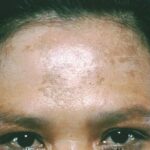
Melasma, generally known as a pregnancy mask, is also a type of skin hyperpigmentation. We don’t really know all the details about why it happens. There are many factors involved, such as exposure to the sun and increased estrogen during pregnancy.
Melasma frequently affects the face, but it can also affect the arms and back of the chest. After childbirth, melasma will persist in women with darker skin and gradually diminish in women with lighter coloured skin.
Pregnancy Line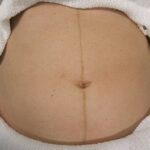
The linea nigra, also known as the pregnancy line, is localised hyperpigmentation. It usually occurs during pregnancy and is a brownish line that connects the belly button to the pubis. This line appears at the same place as where the abdominal muscle separates, called diastasis recti.
Hyperpigmentation recommendations during pregnancy:
- Apply SPF 45 (or higher) sunscreen daily to prevent melasma (pregnancy mask). Rain or shine, summer or winter, always use sunscreen.
Hyperpigmentation recommendations after childbirth:
- regnancy hyperpigmentation gradually diminishes after birth. You have to be patient as it can take up to a year.
- As noted above, melasma can persist in some patients. You should consult for specific treatment if this is your case. You also need to use adequate sunscreen. After an evaluation, dermatologists can prescribe a special cream (hydroquinone) which needs to be applied every day to reduce pigmentation cell activity. It will usually be effective after 3-4 months. Laser treatments are also very effective.
- Melasma is rather difficult to eliminate. You should see a dermatologist before becoming pregnant again to reduce the impact. The accumulation of spots after several successive pregnancies can make it very difficult to eliminate melasma completely.
Pregnancy Acne and the Formation of Cysts
It’s funny, but many pregnant women say that their skin has never been so soft and smooth. On the other hand, some complain of widespread and unpleasant acne problems. Each woman is different, and each pregnancy is too.
Definition and Explaining Why:
Acne is a prevalent dermatological problem that is a combination of:
- Papules (red pimples)
- Pustules (whiteheads)
- Open and closed blackheads
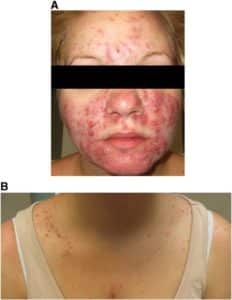
There are many causes of acne, which includes the blockage of pores. This leads to an inflammation of the gland and skin hair. The secretion of sebum, a fatty substance, is associated with hormones. Sebum production is also a critical factor in the appearance of acne.
Sebaceous gland activity (skin glands) is generally increased during pregnancy. This is associated with physiological changes. These glands produce the small yellowish bumps found in the areola surrounding the nipples, called Montgomery tubercles. These special sebaceous glands use a natural oil to lubricate the nipple for breastfeeding.
Concerning sebaceous gland activity and its impact on acne during pregnancy, it can vary from one woman to another. Some women note an improvement in their acne, while others a deterioration, and even the spread of their acne. It really depends on the case.
Acne recommendations during pregnancy:
- Use a mild cleaner 1-2 times a day, for example, mild hydrating soap.
- Acne creams are considered safe given their low absorption risk. Even if major studies have shown that topical retinoids are safe, many dermatologists recommend terminating their use during pregnancy. Most other prescribed creams are fine during pregnancy (ex.: azelaic acid, topical antibiotics, benzoyl peroxide).
- Talk with your dermatologist about taking oral medication if necessary, as some acne outbreaks can and must be treated to diminish the risk of scarring. The medication used during pregnancy is an antibiotic.
- Accutane (isotretinoin) is not to be used during pregnancy. Ideally, stop the treatment at least one month before trying to become pregnant as Accutane can cause fetal malformations.
Ance recommendations after childbirth:
- Use a mild hydrating soap 1-2 times a day.
- All prescribed acne creams are fine with the breastfeeding period (ex.: retinoids, azelaic acid, topical antibiotics) except, once again, for Accutane.
- If you have severe acne outbreaks, talk with your dermatologist about oral medications to reduce the risk of scarring.
You can take certain antibiotics or hormones while breastfeeding, which can help with specific situations.
Stretch Marks during Pregnancy
Definition and explanation why:
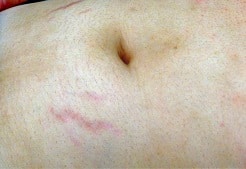
Stretch marks, which are medically known as striae gravidarum, occur in about 63% of pregnant women. They are bands of skin that appear stretched, often red or purple (striae rubra), which mainly affect the abdomen, breasts, buttocks and thighs. Stretch marks usually appear during the sixth or seventh month of pregnancy, and sometimes earlier. They will become white (striae alba) over time.
Many factors can cause stretch marks, including hormonal changes, genetic predisposition, and the physical stretching of the skin.
The literature highlights risk factors: the mother’s young age, family history, pre-pregnancy and pre-childbirth weight, and the baby’s weight at birth.
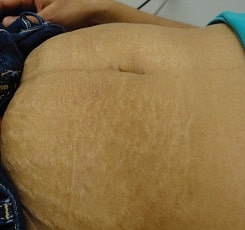
The central hypothesis is that the hormonal environment during pregnancy makes the skin more susceptible to being overly stretched. This stretching breaks down the structure of the skin’s tissue, the skin’s collagen due to the stretching effect, and leads to the appearance of stretching, so that’s why we call them stretch marks.
Since the hormonal and genetic aspect is very present, it is scientifically challenging to prevent stretch marks, because we can’t control heredity and physiological changes during pregnancy.
Recommendations for stretch marks during pregnancy
- During a healthy pregnancy, continue to be physically active and gain a healthy weight set by the doctor monitoring their pregnancy.
- There is little evidence concerning stretch mark prevention. Some studies have shown that daily massages with creams containing Centella Asiatica (trofolastin cream) can have a slight beneficial effect.
- Hydrating your skin daily can’t hurt, but there is no scientific evidence about the results. Even “anti-stretch mark” creams can’t perform miracles. You are born with the skin you have!
Recommendations for stretch marks after childbirth:

- To reduce redness, vascular laser procedures can be tried. But over time, the stretch mark will become white if not treated.
- Retinoid-based creams, if used daily on the abdomen or elsewhere for 3-7 months, may show an improvement of about 20% according to some studies.
- There are very few treatments available. Laser treatments done by professionals have shown improvements of 50-70% according to some studies, but they are expensive.
As observed, many skin changes occur during pregnancy. It’s important to understand that these changes are often beyond one’s control, and with time, they may be easier to accept.
Marie Fortier
The Baby Expert
Updated article : March, 2025.


